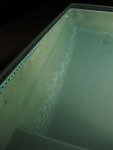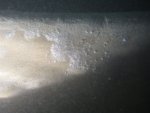Re: Ascorbic Treatment to rid Pool of metal stains
The solubility product of calcium oxalate (CaC2O4) is 2.32x10-9 for the monohydrate to 1.5x10-8. Oxalic acid is essentially fully dissociated at pool pH -- it's essentially a strong acid for your purposes which is why you saw the pH drop so much. The calcium concentration at 300 ppm is around 2.9x10-3 (accounting for ionic strength) so precipitation might start occuring when the oxalic concentration gets above 8x10-7 or only 0.07 ppm. So it's not surprising you saw it cloud up. It basically limits how much you can realistically add. Given the range of Ksp and the over-saturation usually needed, I'd say you might be able to get away with around 1 ppm oxalic acid before you start running into trouble. That would be only 1.3 ounces weight per 10,000 gallons -- I bet you used a lot more than that.
Now the good news is that as chlorine oxidizes the oxalate, the precipitate should dissolve so if you waited long enough you could get rid of it, but of course if there is a lot of it then it's probably better just to filter it out.
As for being a Calcium Hardness (CH) remover, that's interesting and sounds like it should work -- one would make sure the chlorine is low when starting since the chlorine is just going to get used up in the process. Let us know, however, if you notice any calcium oxalate scale forming on surfaces or if it, hopefully, just clouds the water and forms a precipitate that can be removed via filtration, possibly aided by clarifier or flocculant. The good news is that once it is removed, any remaining oxalate can be removed by chlorine. Of course, removing any substantial amount of CH would produce a lot of precipitate -- probably too much to filter so flocculation would be the main approach.




